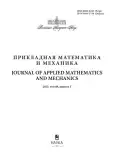Prikladnaâ matematika i mehanika
The Journal of Applied Mathematics and Mechanics (J. Appl. Math. Mech., Prikladnaya Matematika i Mekhanika, PMM) is the oldest periodical publication specifically devoted to problems of mechanics, published by the Russian Academy of Sciences.
The journal publishes results (model building, analytical, numerical and experimental) in the field of mechanics that have not been previously published and are not intended for simultaneous publication elsewhere, with the exception of the journal "Doklady RAN", in the following areas:
- general mechanics or systems mechanics,
- fluid mechanics,
- mechanics of solids,
- mathematical methods in mechanics,
- multidisciplinary problems of mechanics (biomechanics, geomechanics, etc.).
The journal also publishes review articles in these areas. Authors are required to meet the quality demands of the publisher. An impersonal presentation is recommended.
The journal presents, to some extent, the most important ideas and results that determine the development of mechanics, the establishment of new scientific trends and the emergence of new applications of mechanics in an epoch of rapid scientific and technical progress.
The papers published in the journal reflect the advances in all the above four areas of mechanics. Review papers are accepted only if they provide new knowledge or a high-caliber synthesis of important knowledge, following preliminary approval by the editorial board.
An English translation was published under the title Journal of Applied Mathematics and Mechanics from 1958 to 2017 (see website of Elsevier). Since 2018, translations of articles have been published in special issues of the journals Mechanics of Solids and Fluid Dynamics.
Media registration certificate: ПИ № ФС 77 – 82145 от 02.11.2021
Current Issue
Vol 89, No 5 (2025)
Articles
 677-678
677-678


Influence of solid surfaces on the evolution of incompressible fluid jets. Part 1. Jets emerging from an orifice perpendicular to an infinite solid plane
Abstract
 679-702
679-702


Structure of a locally turbulent flow formed when a part of the fluid leaves into the side branch of a circular tube
Abstract
 703-717
703-717


Experience of direct numerical simulation of turbulent boundary layers in complex flows
Abstract
 718-751
718-751


Stability of a three-dimensional boundary layer with s-shaped spanwise velocity profiles
Abstract
 752-764
752-764


On the Flow Field of a Submerged Swirling Non-Self-Similar Jet of Viscous Incompressible Fluid Determined by Exact Integrals of Motion
Abstract
 765-783
765-783


Generalized Helical Flows
Abstract
 784-796
784-796


Influence of viscosity on the behavior of a drop (bubble) in liquid under the influence of vibrations
Abstract
 797-810
797-810


On a partially invariant solution of gas dynamics equations
Abstract
 811-824
811-824


Modeling dissipative processes in open and closed hydrodynamic systems
Abstract
 825-842
825-842


Potential Jet Flows of Burning Fluids
Abstract
 843-860
843-860


Power-law elliptical bodies of minimum drag in approximation of newton pressure coefficient law
Abstract
 861-876
861-876


The Stability in Couette–Taylor Flow of a Viscoelastic Kelvin–Voigt Fluid
Abstract
 877-888
877-888










